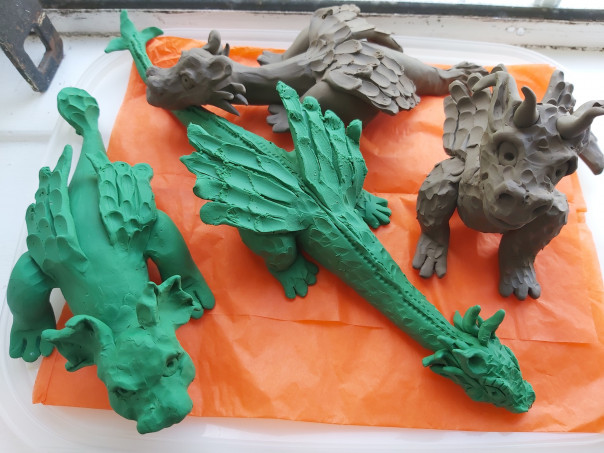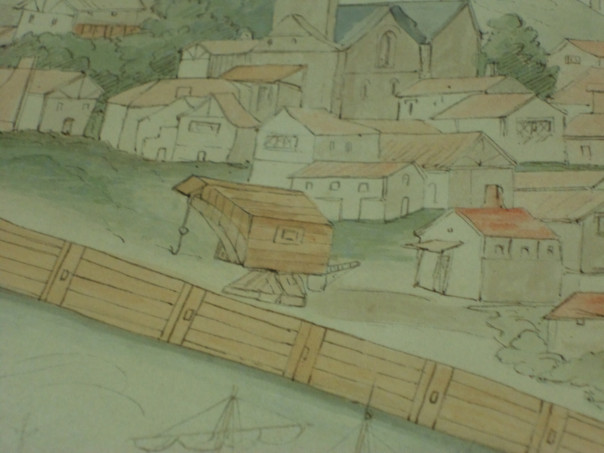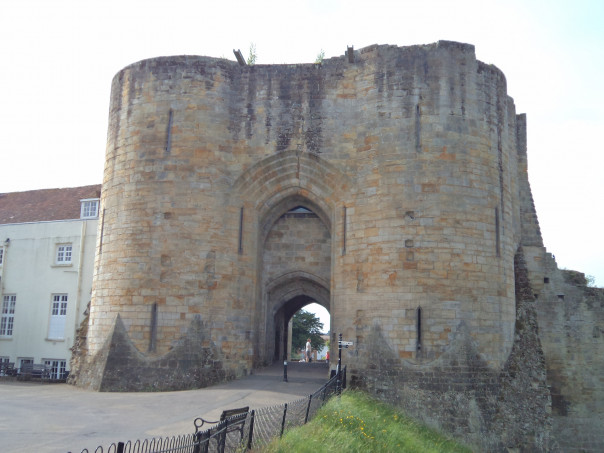Great to see that there is an appetite for the Medieval Canterbury Weekend 2024 and I’m pleased to report that ticket sales have started well. If you are new to our annual History Weekends, please do explore the programme for 26 to 28 April which can be found through both: https://ckhh.org.uk/mcw and canterbury.ac.uk/medieval-canterbury and we will be delighted to see you there. Ben has added Craig’s CCCU Bookshop virtual bookshelf to the website at: https://bookshop.canterbury.ac.uk/canterbury-history-weekend-2024 and the link is also on the MCW24 front webpage.
Dr Diane Heath and her ‘dragon wranglers’ have been busy at the Franciscan Gardens, even in this very cold weather, and the new ‘green dragon’ is coming along. I believe this one is more brick than stone compared to previous specimens, but of course this will be invisible once the sculpture is covered with the clay mix and sedum over the top to turn him/her into a ‘green dragon’. I hope to have a photo soon.

Things are similarly progressing concerning our ‘Migrants, Merchants and Mariners in the Kentish Cinque Ports, c.1400–c.1600’ study day which Dover Museum, in conjunction with the Maison Dieu, will be kindly hosting on Saturday 23 March. This is a summary and hopefully a poster with this and booking details will be available shortly. It will be a free event starting at 10am and finishing at 4pm comprising talks and our pop-up exhibition, space is limited so please do book. The schedule in outline: 10am welcome, followed by Dr Craig Lambert on an Introduction to the Kent’s Maritime Communities, c.1400 to c.1600 project; me on Kent as a ‘Gateway County’. After a break, our final talk for the morning will be The Maison Dieu and the Sea by Kieron Hoyle. Lunch follows between noon and 1pm and there are several nearby refreshment outlets because Dover Museum is located in the Market Square, also useful for those seeking coffee etc during the morning and afternoon breaks. The afternoon opens with a talk by Jason Mazzocchi on The Free Fishermen and Dredgermen of Faversham, to be followed by Dr Robert Blackmore speaking on Maritime Trade and Kent’s Ports. We’ll then have a break before Dr Lambert again on Kent’s Ships and Mariners followed by our concluding Roundtable session. Moreover, we’ll be around all day and will be happy to discuss the pop-up exhibition with members of the audience.
I’m waiting to hear from Dr Claire Bartram about the first Aphra Behn day – the one-day conference on Inspirational Women Writers in Kent on Saturday 2 March, but I have the booking details for the Inspirational Women of Kent co-creation workshop from Dr Catriona Cooper. This one-day workshop will offer participants the chance to be involved in co-creating a digital exhibition celebrating Kent’s Inspirational Women by linking Aphra Behn to her work in contemporary issues and stories. If this sounds interesting, this is the link: https://www.canterbury.ac.uk/arts-and-culture/event-details.aspx?instance=441806
In other news, Dr John Bulaitis was a recent speaker at the unveiling of a plaque to commemorate the east Kent volunteers who left from Dover to join the International Brigades in the Spanish Civil War between 1936 and 1939. Dover was the point of embarkation for the many hundreds of volunteers nationally of which about twenty were east Kent. The new blue plaque was unveiled on 13 December and it looks out towards the port of Dover. The plaque names three men who died in conflict, and one of the people present at the unveiling was Tracey Buckley, who is the granddaughter of Harry Addley, Harry having died while fighting Italian and German tanks at the Battle of Boadilla in December 1936. If you would like to read more about this, please see: https://international-brigades.org.uk/uncategorized/a-plaque-for-the-east-kent-volunteers/

For the main section this week, I thought I would report on Maureen Mcleod’s presentation to the Kent History Postgraduates. She focused on three of the men who were involved in the break-up of the deer parks and chases in Tonbridge in the 16th and 17th centuries, exploring common factors as well as their individual personalities. All three were well versed in the law, including George Hooper who had first followed the family business as a scrivener. This meant they were all perfectly comfortable in the world of land transactions and used their knowledge and accumulated wealth to acquire leases of land in the various parks and chases. Nor were they concerned about court litigation and David Willard might even be said to have apparently relished the opportunities sailing close to the wind might bring. For example, he was reported as having stripped a large acreage he had acquired of its timber, turning it into scrubland and therefore worth far less. For amongst other uses such wood was valuable as fuel for the iron industry in which he, too, had interests. Furthermore, he was behind the revival of the ‘buck’ tithe, which as the holder of the land and the tithe farmer he received from himself, but when he then leased the land, he was able to claim it from the new tenant as his due. Interestingly, he almost came unstuck as a member of the rebels during Wyatt’s Rebellion, but even if he did not escape completely unscathed – he was fined but then pardoned – he seems to have been a born survivor. However, I think the point Maureen made about his actions at Tonbridge Castle rather summed up the man from my perspective. He acquired the lease of the castle and proceeded to strip the lead and timber from the roof to such an extent that it became uninhabitable. Then when he was accused of such asset stripping, he blamed Cardinal Wolsey notwithstanding for this to be the case obviously nobody had noticed that the roof had disappeared 50 years earlier!

A later lessee of Tonbridge Castle was Thomas Weller, a direct ancestor of Jane Austen, who came from a family of clothiers and who himself was a manorial steward, lawyer and landowner, especially of land in South Frith. He, too, was active in the iron industry but not in Tonbridge and during the Civil War was a tax collector for the Parliamentarians. Yet it was what he did at Tonbridge Castle that again drew my attention and the thought of using the grounds to plant fruit trees and have a rabbit warren is fascinating. However, I’ll leave you to find out what happened to the trees and the rabbits!!
This leaves George Hooper, and Maureen drew attention to his acquisition of the Cage (hunting park,) as well as his other properties which he seems to have valued perhaps solely for the rents they brought in. As she said, his will is extremely interesting and appears to denote a pious individual of a more Calvinist persuasion. Furthermore, although the direct line of the family died out in the 18th century, the family firm continues and is the oldest surviving legal business.
As you might expect, this fascinating presentation drew a number of questions and a lively discussion, so many thanks Maureen and in February it will be Jane Richardson’s presentation.
 Centre for Kent History and Heritage
Centre for Kent History and Heritage Sheila Sweetinburgh
Sheila Sweetinburgh 2004
2004

